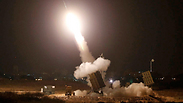
IDF's hesitant opening strike
Analysis: While Hamas was well prepared for conflict, Israeli army missed opportunities to hit organization's rocket arsenal and target its commanders.
Deif's achievements are clear: Hamas, which was in distress, put its distress on the top of the agenda. It fired heave barrages at Israel's southern and central cities and sent half the country into bomb shelters and secure spaces.
Hamas was well prepared for a conflict, both with offensive tunnels and an ability to infiltrate Israel from the sea and from the air, and it may have additional surprises in store.
On the opposite side, the IDF responded with a hesitant opening strike, missing opportunities and lacking any surprises, which in the meantime has claimed a low price from Hamas in terms of casualties.
Operation Pillar of Defense, for example, began with the assassination of Hamas' military chief, Ahmed Jabari. Operation Cast Lead, which preceded it, claimed hundreds of casualties from Hamas and began with a wave of airstrikes on its bases. Two days earlier, the government approved the opening of crossings in Gaza, basically putting Hamas to sleep.
The IDF launched Operation Protective Edge reluctantly, and the results at this stage are unimpressive. The army was supposed to prepare for this battle – especially the aerial one, which depends on better intelligence – in order to keep the round as short as possible and remove half the country from the circle of threat.
In the past year, the army has warned against Hamas gaining strength with 80-kilometer-range rockets. The army had an excellent opportunity to hit them and erode the number of rockets as much as possible, just like it did on the first day of Pillar of Defense, but this was not done although the senior defense echelon's estimated that these missiles would be directed at central Israel. And indeed, on Tuesday evening Hamas managed to launch rockets into the center.
If we compare the quality of the targets which have been hit, compared to previous operations, here too we can see a significant and troubling decrease. The defense minister says the operation will intensify as time goes by, but it's uncertain that the IDF will have opportunities to attack, and it will definitely find it difficult to conduct targeted assassinations against the senior members of Hamas' military wing, who have already entered the bunkers prepared in advance.
Hamas has learned how to deal with the IDF's rocket hunters, which operate in the air and on the ground, and it launches automatically. That's another reason why the organization has a low number of casualties.
At the same time, the organization is trying to evade the Iron Dome system by firing heavy barrages at several targets simultaneously, but so far the system has proven itself with more than 30 interceptions.
In order to avoid using interceptors, the Air Force has decided on a strict procedure for the system's operation. And so the hidden missile, which costs about $50,000 per missile, is only launched when there is a high probability of rockets hitting a constructed area.
An Israeli achievement in this operation will be a return to the Pillar of Defense understandings, which led to a calm that lasted about a year and slowly disappeared. For this purpose the army is seeking to restore its deterrence, which will bring another period of calm, but in the meantime without great success.
The defense establishment, therefore, is not prepared to accept understandings for the end of round as it wanted to up to two days ago – this is also out of an understanding that what is happening here is being closely monitored in Lebanon and Syria.










